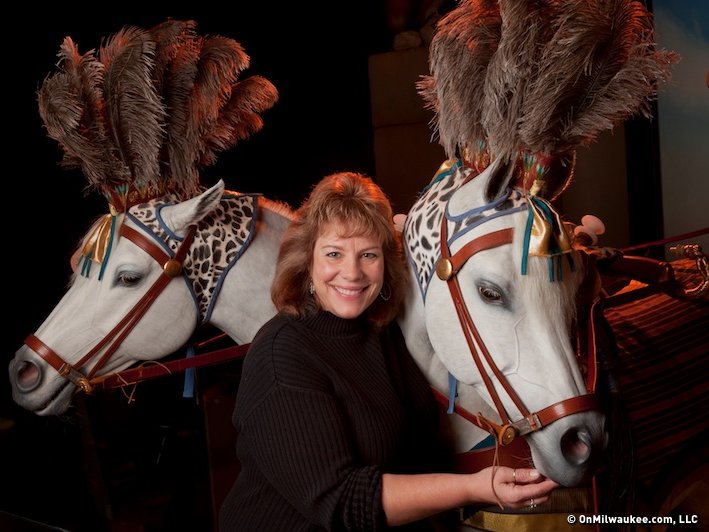The leather jacket. It’s not just a piece of clothing. It’s a symbol, a uniform, a battle flag – a coat of armor even. And more than anything, it’s just plain cool.
The Harley-Davidson Museum is currently hosting the exhibit "Worn To be Wild: The Black Leather Jacket," which runs through Sept. 3. The exhibit has been in the works for a few years, says the museum's curatorial director Jim Fricke.
"We’re always looking to bring new audiences to the museum, and a subject that naturally combines motorcycling, transportation and military history, rock n’ roll, Hollywood and fashion was just too good to pass up," he said.
"We decided to focus on that classic biker jacket, show how it evolved as a functional garment, and then how it took on other cultural meanings and became an internationally-recognized symbol of rebellious cool."
Thursday night the museum gathers three people who were invaluable in creating the exhibit to participate in a roundtable discussion hosted by Fricke. "Untold Stories: Rockers, Rebels and Runways: The Black Leather Jacket" features Karen Davidson, Creative Director of Harley’s Motorclothes division; Debra Nadoolman Landis, Hollywood costume designer and creator of the Indiana Jones signature look and Michael Jackson’s "Thriller" jacket; and Howard Kramer, Curatorial Director at the Rock and Roll Hall of Fame and Museum.
"We’ll have a freewheeling discussion, with lots of images and video to illustrate," said Fricke. "Like the exhibit, it’s a unique opportunity to experience something like this in Milwaukee, and we’re proud to host it at the museum."
OnMilwaukee.com talked to the panelists about the leather jacket and what it symbolizes in modern American culture, resulting in a multifaceted study of the history of one of the most evocative accessories of the 20th century.
In the beginning
"We started leather in 1921, when a leather coat was featured in our accessories catalog," said Davidson, who is the great-granddaughter of company co-founder William A. Davidson. "It’s the most logical, effective, protective item of clothing when you’re out in the elements.
"The biker jacket as we know it today was originally developed for the New York City Police Department in 1938. We picked it up in 1947 and began selling the classic black motorcycle jacket."
But Davidson said that function quickly gave way to fashion. The lifestyle of the motorcycle enthusiast came to represent much more than owning, maintaining and riding a bike – and therefore, so did the biker jacket.
"Once we launched it, it was picked up quickly with the onset of motorcycle clubs and it became adorned. That’s what’s so inspiring for us today – we watch how the quintessential biker jacket morphed into a canvass for personalization," she said.
"You saw club logos. Studs. People were so in love with their leather and with this jacket; it was the symbolism of the life they led. The road warrior and his gear, his armor – they relied on it so they became very attached to it."
It was becoming much more than a trend. With the plethora of patches, pins and embellishments from which riders could choose, said Davidson, it quickly became a bold statement of individuality.
"People are proud to say ‘This is the life I lead. This is where I go. This is where my lifestyle takes me. I go everywhere. I’ve been everywhere,’" she said. "It’s such an expression of how the lifestyle has empowered them to feel free."
It isn’t about a look. It’s about a culture.
"People don’t want to pick up on a trend," said Davidson. "They admire the true, hardened road riders and the authentic club members. And then of course it was picked up by celebs, and it’s become iconic."
"A thousand-yard stare"
The Rock and Roll Hall of Fame and Museum donated three pieces to the exhibit, and its curatorial director Howard Kramer said that each is a unique incarnation of the spirit of rebellion and independence so embraced by riders and those who admire them.
And what more appropriate milieu for rebellion and independence than the world of rock and roll?
One of the pieces donated by the museum is a Brooks leather jacket worn by rocker Joe Walsh on the cover of "James Gang Rides Again."
Undeniably, it’s a powerful, gritty black-and-white image. No one can doubt that these leather-clad musicians atop their bikes on a snow-dusted road are not just pawns of a fad. They are manipulating the fad; they’re making it their own.
Musicians speak through their music, said Kramer, but they also speak through their costume choice.
"The performers adopted these visual identities and youth culture going back to the '50s, and in particular the motorcycle is an expression of individuality," said Kramer. "The guys who wore leather jackets first were pilots. They were tough guys. To risk your life by getting into something suspended from the sky? That got translated into getting onto a motorcycle on the ground."
And, of course, into stepping onto a stage with a guitar.
The Religion of the Leather Jacket
Deborah Nadoolman Landis has created costumes for actors and musicians for decades, and she knows as well as Kramer the power of a leather-clad rocker. In creating looks like Michael Jackson’s "Thriller" red leather jacket and Indiana Jones’ signature style, Landis had the task of conveying a character’s personality through his clothing.
"We’re not trying to design for characters in a movie. We’re trying to make them people," she said. "So how do you make Indiana Jones a believable and unique person?
"He’s heroic and he’s extremely vulnerable and extremely fallible, he’s kind, he’s lovable – so all of this essence is somehow embodied by his clothes and his jacket and hat. And when people leave the movie theater, they want to be him. They want to encompass all these wonderful, alluring parts of that character on that screen."
The same goes for Michael Jackson.
"We had to think – what would be appropriate for Michael to wear dancing in a dark street surrounded by ghouls?" she laughed. "You put on that jacket and you feel like you can dance."
Landis knows the language of clothing, and the power a certain piece – like a leather jacket – has to convey spirit its wearer.
"Everything that we’re wearing right this second is here for a reason," she said. "It’s a choice we made and it has a story. There are stories all about your shoes – where you got them, how much they were, who you were with, how long you’ve had them … your pants, your jacket, everything you’re wearing has these stories and that’s part of our narrative. The people in the movies are no different from us."
Indiana Jones without his leather jacket is like Samson without his hair. And Landis says there’s a good reason for that.
"You had to believe, and we were asking the audience to believe, that even if his closet was ginormous and he could’ve worn anything that he would have gone back to that piece of clothing," she said. "These leather jackets are designed for these characters to express vulnerability, to express warmth, humanity. They’re incredibly sensual, they drape – it’s just like putting on something of your own self."
Landis agrees with Davidson that the leather jacket allows people not to become followers of a trend, but rather participants in it.
"I just came from ComicCon, where I saw 50 Indiana Joneses, including a father and son from China. I’ve seen Indiana Joneses from Peru, Indiana Joneses who are 5 years old, who are 50, who are 90," she said. "Those people who become him – it’s about becoming. It’s like a religion, isn’t it? It’s about transformation. You put something on and then you embody it. And leather jackets really have that kind of elixir."
Colleen Jurkiewicz is a Milwaukee native with a degree in English from the University of Wisconsin-Milwaukee, and she loves having a job where she learns something new about the Cream City every day. Her previous incarnations have included stints as a waitress, a barista, a writing tutor, a medical transcriptionist, a freelance journalist, and now this lovely gig at the best online magazine in Milwaukee.







